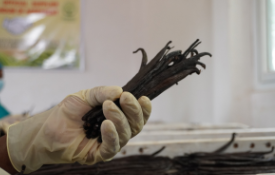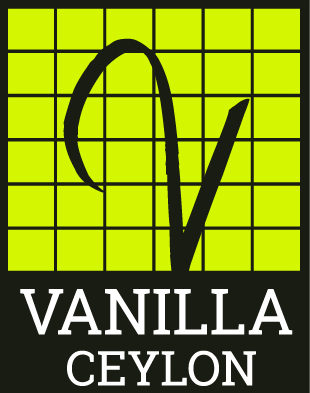
Where does vanilla come from?
Vanilla is derived from the string-bean-like pod of an orchid. The flowers are greenish-white and bloom for a short time and lack scent. Because the flowers last only for a single day, they have to be treated with care and precision to ensure that they are pollinated on time. The beans will mature after six weeks of fertilization, however they are not harvested until a few months more.
Once the vanilla bean is mature, the farmers immerse the beans into boiling steaming hot water, to block maturing process; then they dry and process them by sweating them in blankets, sweating boxes racks, ovens, and sweating boxes as they slow cure in the sunlight for between six and nine months, bringing the moisture content to about 30 percent.
The delicious flavor and aroma do not adorn the plants. It’s only when the beans begin to ferment into brown and wrinkled pods that that that legendary strong smell begins to be heard in the air.
What is the best kind in vanilla extract?
The answer is comprised of two key components.
First, there is it of good quality. There is a wide variation in the manner in which vanilla extract is created. The temperature, the quality of vanilla bean used, the quantity of vanilla beans used, the quality of alcohol, kind of alcohol used, the length of extraction, and the temperature during extraction play a part in enhancing the flavor of vanilla extract. Making a high-quality vanilla extract is an exact science. Every single one of our extracts is made by America. United States
The second is the kind of vanilla bean that is used. Each variety of vanilla bean has its own distinctive flavor:
- Mexican Vanilla is dark and bold with smoke tones.
- Madagascar Vanilla is smooth and rich.
- Beanilla Vanilla is an amalgamation of Bourbon as well as Tahitian vanilla. The blend has a stunning floral scent and a smooth cherry-chocolate-like flavor. Beanilla Vanilla is a two-fold vanilla extract, meaning it’s twice as strong than the standard.
What amount of vanilla beans do I need to use to make homemade vanilla extract?
5 beans per 8 ounces alcohol.
It is built on FDA demand to commercially produce vanilla extract that is single-fold. This is the most significant component of making vanilla at home.
What is the most effective type in vanilla beans?
The “best” kind of food depends on your personal preferences in taste. Madagascar is by far the most sought-after kind as well. Indian is a favorite that has been around for a long time. Each type has its own distinct characteristics:
- Madagascar Vanilla – thick and creamy
- Mexican Vanilla – strong, dark, and smokey
- Indian Vanilla – chocolate in full
- Indonesian Vanilla – moderate well-balanced
- Tahitian Vanilla – floral, cherry-chocolate
- Tonga Vanilla – earthy, fig, raisin
How can I conserve Vanilla Beans?
We get frequently asked “What can be the ideal method for storing vanilla beans? and how long do they last? ” In contrast to the dried-up or brittle beans you can purchase from the local supermarket the vanilla we sell is oily, soft and fresh. The high inventory turnover ensures that the vanilla you purchase is as fresh as it can be. In contrast to the overpriced dried vanilla beans you can find in the local supermarket Our vanilla doesn’t sit on shelves for lengthy durations and we make extra efforts to protect the quality and moisture. If you follow our tips in the following paragraphs, we can assure that your vanilla will be in good condition for a long duration:
- UnpackingThe vanilla beans we offer are shipped in glass or vacuum sealed vials. If you receive your vanilla in a vacuum sealed package, we recommend that you avoid opening the box until the time of use. We suggest that you take the vanilla beans from the container within six months. Be aware that you may notice a brown liquid in this vacuum seal packaging. Don’t be worried about it as the liquid is just oil taken out of the vanilla bean during the sealing process. If the vanilla is in glass vials, we recommend that you get rid of the vanilla beans in 3-4 months.
- StorageWrap the vanilla beans in plastic wrap or wax paper and then store them inside an airtight glass, or Tupperware container. Be sure to squeeze the most air possible from the container in order to stop the vanilla beans from drying .
- LocationIt is not recommended to store your vanilla bean in the fridge. The moisture from refrigeration can cause excessive growth in the Grade A Vanilla Beans which can cause the growth of a specific kind of mold specifically associated with vanilla. It is recommended to store an airtight container dark, cool location such as the basement or pantry.
- AiringVanilla beans need to be air-conditioned frequently. Simply take the beans out of the container each week to let the air circulate for about 10 to 15 minutes.
- Life TimeVanilla beans that are kept in good condition and in the right conditions will last up 2 years. We recommend purchasing quantities you plan to use within 6-8 months.
- Dry or moldy Vanilla BeansIf the vanilla beans are dried out, it is possible to refresh them with warm water or milk for a few hours. If the vanilla beans appear to have “frost” Do not believe that it is mold. Frosty Vanillin crystals may form on vanilla beans when vanillin contained within the bean moves to the surface as the beans become dry. They appear shiny and can be eaten. If you suspect mold, you should throw away those vanilla seeds.
How can I make use of vanilla beans?
Have you ever cooked using whole vanilla beans? Absolutely no problem! This is the most effective method of using vanilla in its purest and natural state. If you want to use the vanilla bean, take your preferred cutting boards and sharp knives. Cut off the ends of your vanilla bean. Then, slice through the vanilla bean in a long way. Do not be scared to make use of some force since vanilla beans are known to have tough skin. Once the bean has been divided in half, it’s time to take the paste from the vanilla bean. Keep your knife parallel to the bean and then scrape. It’s as simple as that!
What are the characteristics that make vanilla beans “Gourmet” as well as “Grade A” quality?
This is a common query for anyone who is unfamiliar with fresh vanilla beans. The majority of stores or vendors offer only one kind of vanilla bean, so customers don’t have the chance to evaluate.
The quality of vanilla beans is determined by the amount of moisture as well as length of the bean and the condition. Moisture content is among the most crucial characteristics of premium vanilla. The Grade A (Gourmet Grade) vanilla beans are very humid. The oils should be visible on the exterior inside the bean, and the beans will leave a greasy residue on your fingertips after touching. Vanilla beans with a high moisture content are smooth to the touch and extremely elastic when bent. It is typical to see the oils expand from the vanilla bean packed in vacuum-sealed bags. This is an attribute of a very premium vanilla.
The length of the vanilla bean can also indicate the quality of vanilla. Vanilla beans of grade A generally exceed 6 inches or 15 centimeters, in length. Beanilla vanilla beans typically measure 8 inches (20 centimeters) long. Vanilla beans of Grade A should be able to bend and feel soft to the to the touch. The vanilla beans which appear stiff crack, split, or cracked are categorized as Grade B or Grade C.
Beanilla was born from frustration over not being able to find genuine Grade AAA vanilla beans. Each vanilla bean bag are carefully packed by highly-trained vanilla experts to ensure the highest quality for each vanilla bean.
What is it that makes each vanilla bean unique?
This is an excellent inquiry, especially when you consider the variety of vanilla varieties that exist. There are two primary aspects that determine what flavor and scent of vanilla beans:
- OriginSimilar to fine wine the region in which Vanilla is harvested plays a significant part in the flavor and aroma of vanilla beans. This is due to every country using its own unique method of drying and curing vanilla beans. The variety of curing methods result in a vast difference in the flavor created by vanilla beans.
- SpeciesThere are three primary varieties of vanilla commercially produced. This includes vanilla planifolia vanilla tahitiensis and the vanilla pompona. Each species is unique in its particularities. The species known as planifolia is grown across the globe all the way all the way from Hawaii up to Mexico from Mexico to Madagascar and is the most prolifically produced. The species is generally more round and plump in comparison to other species. However, strong variations do exist. Vanilla tahitiensis is commonly known as “Tahitian Vanilla” is typically has a floral scent and flavor. Tahitian vanilla beans have less vanillin (the active ingredient that gives vanilla its the flavor) and are frequently utilized in perfumes. Tahitian vanilla beans are also known to be broad and flat.
